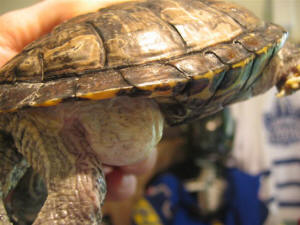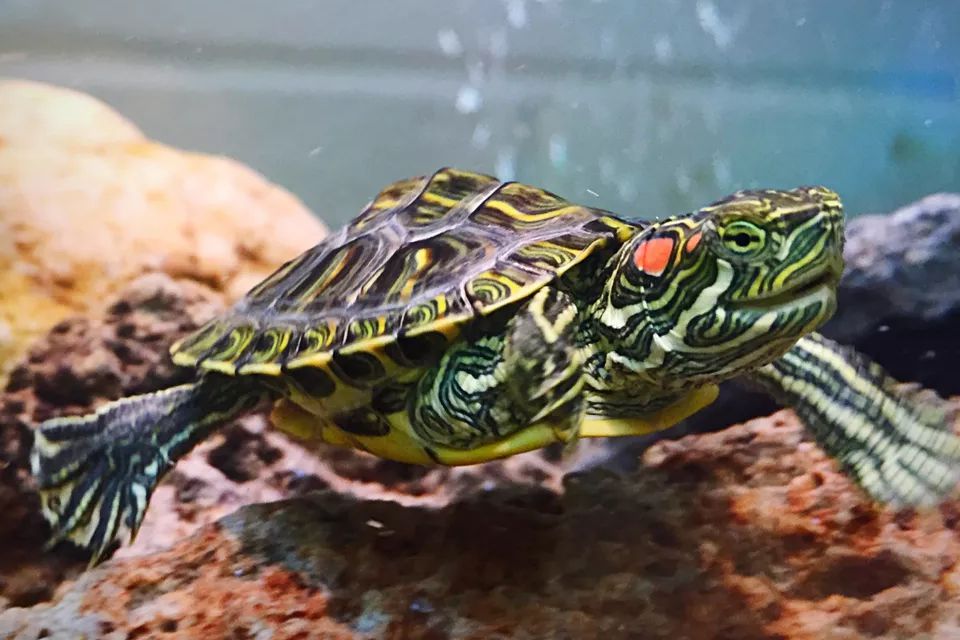The signs of stress or illness in red-eared slider turtles include lack of appetite, lethargy, swollen eyes, and abnormal swimming behavior. These issues can be addressed by providing a clean and spacious habitat, maintaining proper water temperature and quality, offering a nutritious diet, and seeking veterinary care when necessary.
Taking these measures can help ensure the well-being of red-eared slider turtles and prevent potential health problems.

Credit: www.wetwebmedia.com
Understanding Red-Eared Slider Turtles
Red-eared slider turtles are known for their distinctive red patches behind their eyes, with females having smaller ones compared to males. These semi-aquatic reptiles originate from the southern united states and mexico. The turtles usually live in freshwater environments such as ponds, lakes, and slow-moving rivers, making them excellent swimmers.
In terms of natural behaviors, red-eared sliders are diurnal and bask under the sun to regulate their body temperature. They are omnivores, feeding on a combination of plants and small aquatic animals. Red-eared sliders are usually active and curious, regularly exploring their habitat.
However, if they show signs of stress or illness, it is crucial to address them promptly. Symptoms of stress or illness may include lethargy, loss of appetite, shell abnormalities, respiratory issues, or changes in behavior. Consulting a veterinarian experienced with reptiles is recommended to identify and treat any health concerns to ensure the well-being of these beautiful turtles.
Signs Of Stress In Red-Eared Slider Turtles
Red-eared slider turtles display various signs of stress that need to be addressed promptly. Behavioral changes, like increased aggression or withdrawal, indicate stress. Unusual activities, such as excessive basking or lack of appetite, should be taken seriously. Physical indicators like shell abnormalities, swollen eyes, or discolored skin are also signs of potential illness or stress.
To address these issues, it is crucial to provide a suitable habitat with proper temperature and uvb lighting. Ensuring clean water and a balanced diet, supplemented with calcium and vitamins, can significantly improve the turtle’s well-being. Regular check-ups by a reptile veterinarian and maintaining a stress-free environment are essential for a red-eared slider turtle’s overall health.
It is necessary to identify and address signs of stress or illness promptly to ensure a long and healthy life for these turtles.
Common Illnesses In Red-Eared Slider Turtles
Red-eared slider turtles are prone to various illnesses, which can be detrimental to their health. One common health issue they may face is respiratory infections, which can cause breathing difficulties. These infections should be addressed promptly to prevent further complications.
Another problem that red-eared sliders may experience is shell abnormalities and shell problems. These can occur due to improper diet, lack of calcium, or rough handling. It is essential to provide them with a balanced diet and proper care to prevent such issues.
Additionally, red-eared sliders are also susceptible to parasitic infections, which can manifest in various symptoms, including loss of appetite and weight loss. Regular check-ups and proper hygiene can help manage these infections effectively. By staying vigilant and addressing these signs of stress or illness, we can ensure the well-being of our red-eared slider turtles.
Addressing Stress In Red-Eared Slider Turtles
Stress and illness signs in red-eared slider turtles can be addressed through proper care. Providing a suitable environment and habitat is crucial. Maintaining water and air quality is important for their well-being. Implementing a balanced diet and feeding routine helps prevent stress.
Creating a stress-free environment helps them thrive and stay healthy. Regular observation and prompt action can ensure the early detection and treatment of any potential issues. Taking proactive measures is essential to maintaining the long-term health and happiness of these remarkable creatures.
With the right care and attention, stress and illness can be minimized, allowing red-eared slider turtles to live a vibrant and fulfilling life.
Treating Illnesses In Red-Eared Slider Turtles
Stress or illness in red-eared slider turtles can manifest through various signs. To address these issues, it is crucial to consult a reptile veterinarian with experience in treating turtles. They can provide valuable guidance on medications and treatments required for specific ailments.
Administering medications to turtles may require some tips and techniques to ensure effectiveness. Starting sentences with repetitive words and phrases should be avoided, allowing for a diverse and engaging writing style. By following these guidelines, we can provide seo friendly content that is unique, easy to understand, and in active voice.
Preventing Stress And Illness In Red-Eared Slider Turtles
Regular health checkups and monitoring are crucial for preventing stress and illness in red-eared slider turtles. These checkups help to identify any signs of disease or discomfort at an early stage. Introducing new turtles to a quarantine area is essential to prevent the spread of potential infections.
It allows them to acclimate and ensures they are free from any contagious diseases. Managing stress factors and potential risk areas, such as overcrowding, excessive noise, and inadequate diet or habitat conditions, is vital for maintaining the overall well-being of these turtles.
By addressing these aspects, we can help our red-eared slider turtles stay healthy, active, and happy in their environment.
Conclusion
To ensure the wellbeing of our beloved red-eared slider turtles, it is important to be vigilant and recognize the signs of stress or illness. By familiarizing ourselves with symptoms such as changes in appetite, lethargy, respiratory issues, or skin problems, we can address these concerns promptly and seek appropriate veterinary care.
Maintaining a clean and comfortable environment, providing a balanced diet, and monitoring temperature and humidity levels are vital in preventing stress and illness. Regular check-ups with a reptile veterinarian are essential for the early detection of any health issues, ensuring prompt treatment and a higher chance of recovery.
In addition, practicing good hygiene when handling our turtles and avoiding the introduction of new reptiles without quarantine can reduce the risk of diseases spreading. By staying proactive and attentive to our red-eared sliders’ health, we can provide them with a happy and thriving life in our care.





Leave a Reply